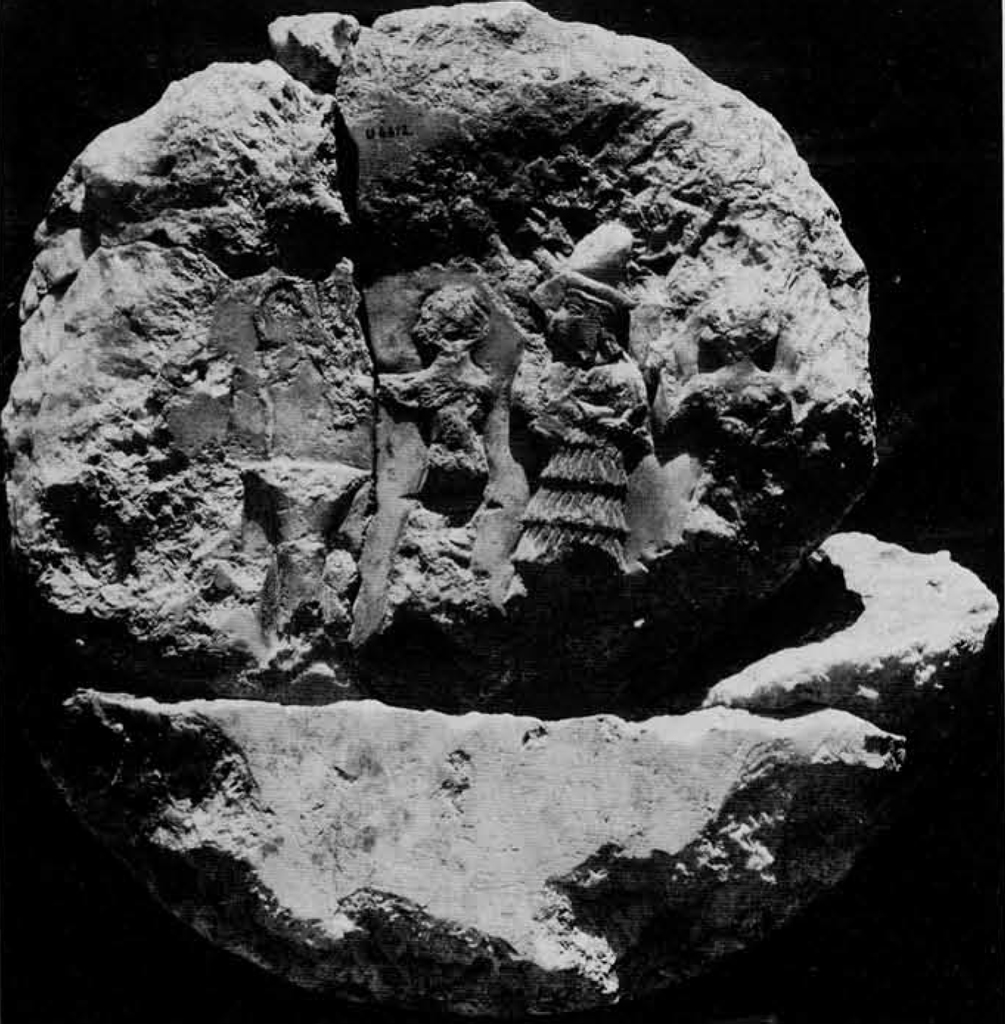Woolley’s excavation of the royal graves at Ur is one of the technical triumphs of Near Eastern field archaeology and his most renowned achievement. It began with an act of remarkable restraint and uncanny foresight by Woolley, whose archaeological ‘sixth sense’ rarely failed him. When he arrived at Ur early in November 1922 he started his excavations with a major trench to clarify an area towards the south of the great temple platform revealed in 1919 by H. R. Hall. Although this trench produced no evidence of structures, it did reveal graves at various depths equipped with vessels of baked clay and stone, metal tools and weapons, as well as personal ornaments of carnelian, lapis lazuli and gold. Faced with this unexpected wealth of finds Woolley made a memorable decision, best described in his own words, “(the) diggers were raw and clumsy, and for the clearing of a cemetery skilled labour is essential . .. we were ourselves new to the country . . . very little indeed was known of Mesopotamian archaeology, so little that the objects … were vaguely dated by such authorities as I could consult to the Neo-Babylonian or, as more probable, to the Persian period”—that is, almost two thousand years more recent than was eventually proved to be the case. Work was not resumed in this area of the site until the season of 1926-27. Then for the next three or four years Woolley excavated season by season hundreds of graves in the southeast corner of what was later to be part of the temple platform. This had been surrounded with a great wall, built by Nebuchadnezzar II (ca 604-562 B.C.), that ran across the site of the earlier cemetery.
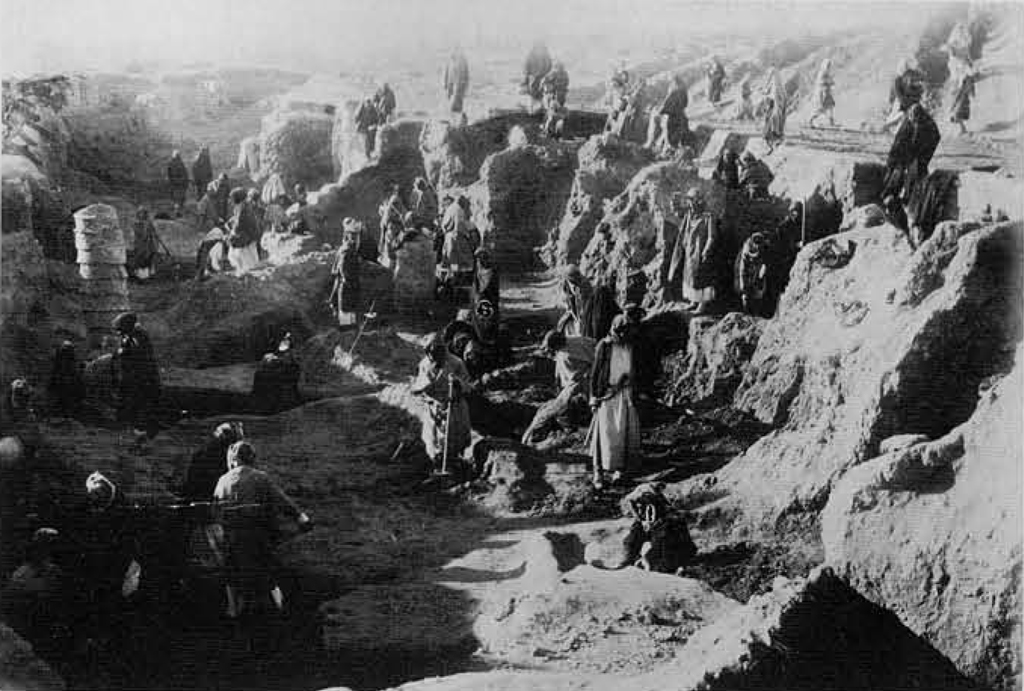
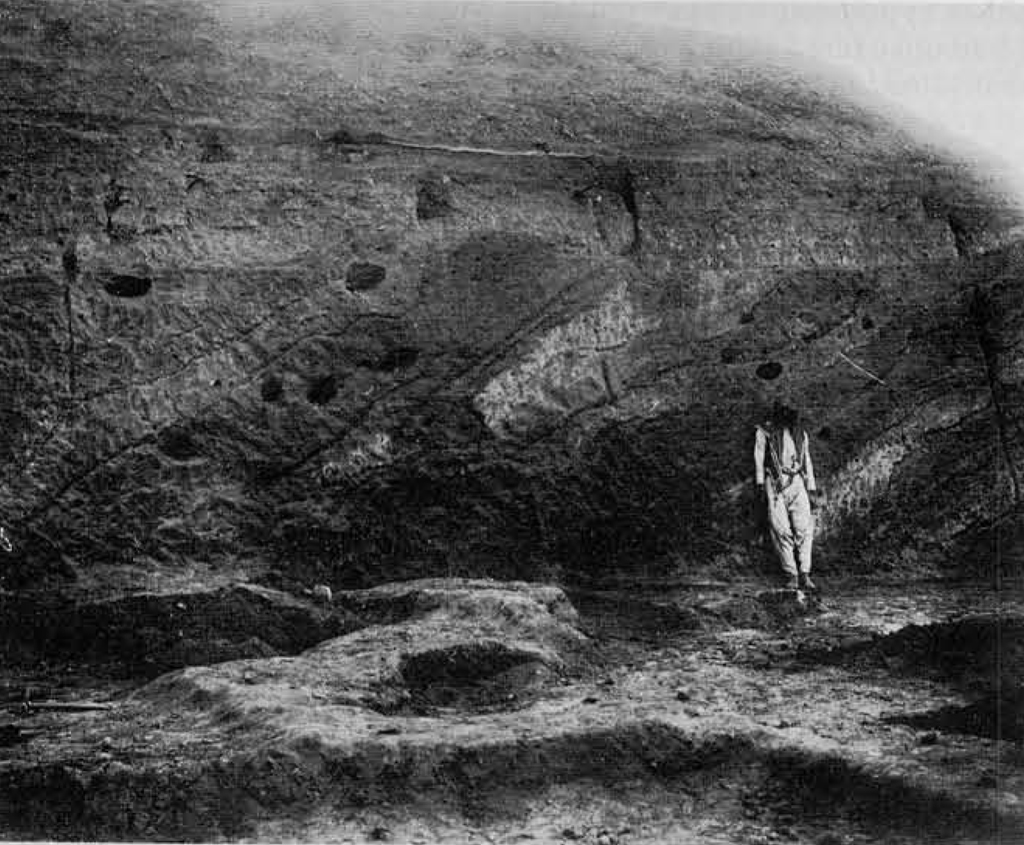
Woolley’s digging showed that the graveyard had lain in an area of waste land used to dump rubbish just below the city walls, as was common practice in Sumer. Already by the time of the cemetery long occupation at Ur had created a mound of settlement debris ( a tell) upon which the contemporary city stood. Its rubbish, sloping away from the walls over which it had been tipped, provided ample room for a burial ground. The relative chronological position of the royal graves was established by the date of seal impressions and tablets in the two major levels of rubbish between which they were sandwiched, called by Woolley ‘Seal Impression Strata (S.I.S.), 5-4 below, 2-1 above. In the upper S.I.S. 2-1 were inscriptions of the ‘First Dynasty of Ur’ as recorded in the Sumerians’ own historical records; in the lower were seal designs and tablets of a more archaic type. In absolute terms, based originally on textual evidence from Mesopotamia and more recently on calibrated Carbon-14 dating as well, the levels in which the royal tombs lay are now dated approximately to the century from 2600 to 2500 B.C. It is a period known in archaeology as Early Dynastic IIIA (sometimes the ‘Fara period’) when for the first time contemporary written records begin to throw real light on the structure and culture, even some of the personalities, of Sumerian society.
A few private graves may predate the royal tombs in this area of Ur; but it was they which gave. the cemetery its significance. In time there was a double row of royal tombs, no doubt extending beyond the area Woolley opened up, all cut down into rubbish tips, more or less similarly orientated, and running across the waste ground from southeast to northwest (see figure 3). Soon private graves clustered as close as possible to the royal graves, at first perhaps marked by some kind of funerary chapel at ground level; but soon private graves actually cut down into the shafts of the royal ones. Private graves continued to be dug, and rubbish tipped, for centuries after the Early Dynastic IIIA royal graves had been cut. All this activity gave full opportunity for the robbery of royal tomb chambers by subsequent grave diggers. Indeed, so intensive was grave digging here that tomb chambers had often been totally destroyed. As a result Woolley’s royal tombs are of two types: those in which he found a tomb chamber (RT. numbers 777, 779, 789, 800, 1050, 1054, 1236, 1618, 1631 and 1648), and those for which only the approach pit was located, described by Woolley as ‘death-pits’, because of the human victims they contained (RT. numbers 337, 580, 1157, 1232, 1237, and 1332).
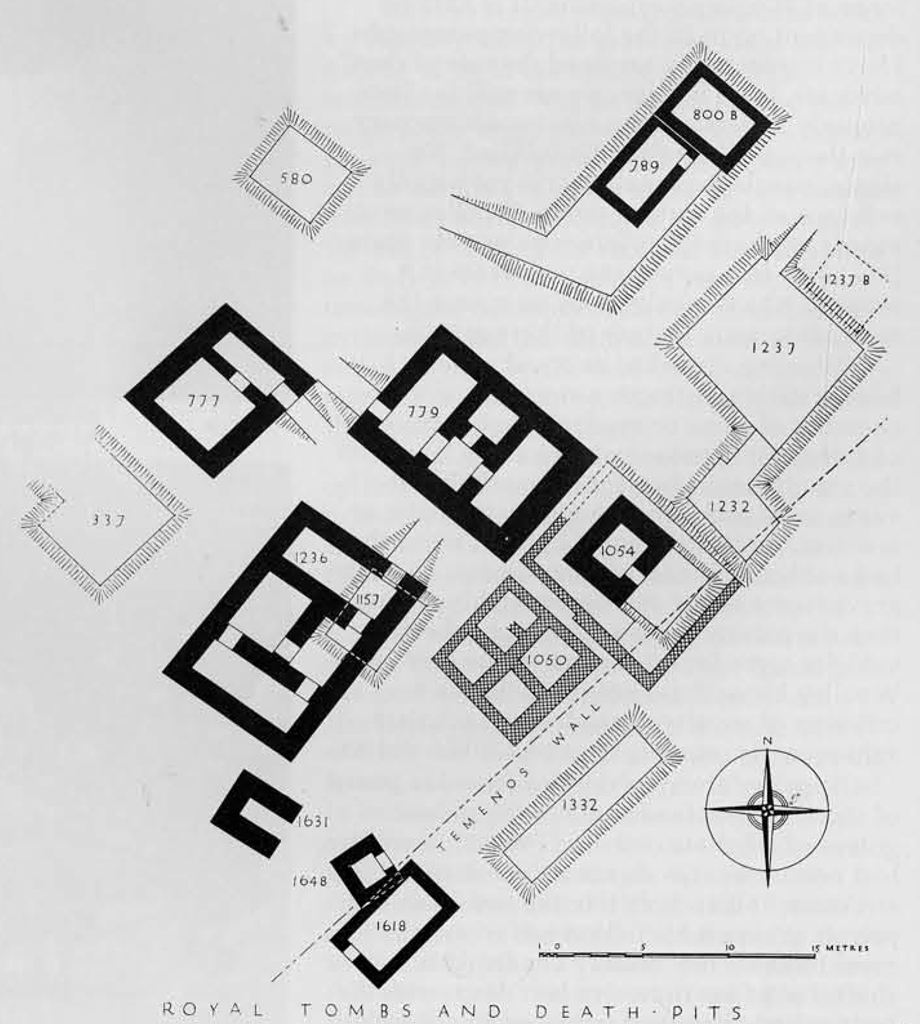
With the enormous publicity his work received, as year by year from 1927 he reported on the sixteen burials distinguished by human sacrifices, speculation was rife about the reasons for this amazing ritual, previously unsuspected in ancient Mesopotamia, which in some cases had claimed so many victims. Woolley himself consistently maintained that these were the tombs of actual kings and queens of Ur, regarded as divine or semi-divine, who on death had been offered the sacrifice of part of their household. One alternative theory was predominant among the many offered to explain the rituals. It maintained that these were not royal tombs in the accepted sense. The primary burials, it was suggested, were of priests and priestesses put to death after they had represented the chief god and goddess of Ur in a ‘Sacred Marriage Ceremony’, upon which the annual fertility of the land was believed to depend. Some scholars, Henri Frankfort conspicuous among them, introduced a secondary argument that identified the participants as substitute kings and queens ritually slaughtered with their attendants once their brief reign was over. As Woolley objected, neither hypothesis explained all the evidence he had uncovered. The textual sources for substitute kings, from Assyria, are much later and even in their own context not completely understood. The ‘Sacred Marriage’, as an annual rite always involving a pair of lovers, would be expected to produce numerous tombs with double interments—and this was not what Woolley had found. Nor did it seem likely, despite gallant protests, that the lady Pu-abi, aged about forty at death, would have been a main participant in such a rite; save perhaps years before her death.
The clarity of Woolley’s arguments and the precision of his deductions from a wide variety of archaeological evidence, scrupulously observed and recorded, are truly formidable. They have rather naturaly deterred re-assessments in the last thirty years and have tended to overshadow the intriguing anomalies he revealed in the royal burials. Woolley was well aware of them, for he always noted what he found with care and attention; but they were inevitably obscured in the general, more popular accounts of his discoveries that he wrote with such apparent ease and conviction. Any attempt to direct attention back to the striking variety of the royal tombs is a constant tribute to the excellence of Woolley’s reporting. It is entirely dependent on it. In the following paragraphs I have intentionally assumed the role of devil’s advocate, for, I believe, we are still far from properly understanding what contemporary role the royal burials at Ur fulfilled. No single, simple explanation will yet happily embrace all the sixteen tombs Woolley excavated; let alone the mysterious private grave (PG.) 755. In a perplexing way there is a sense in which royalty is by no means the most interesting feature of these graves.
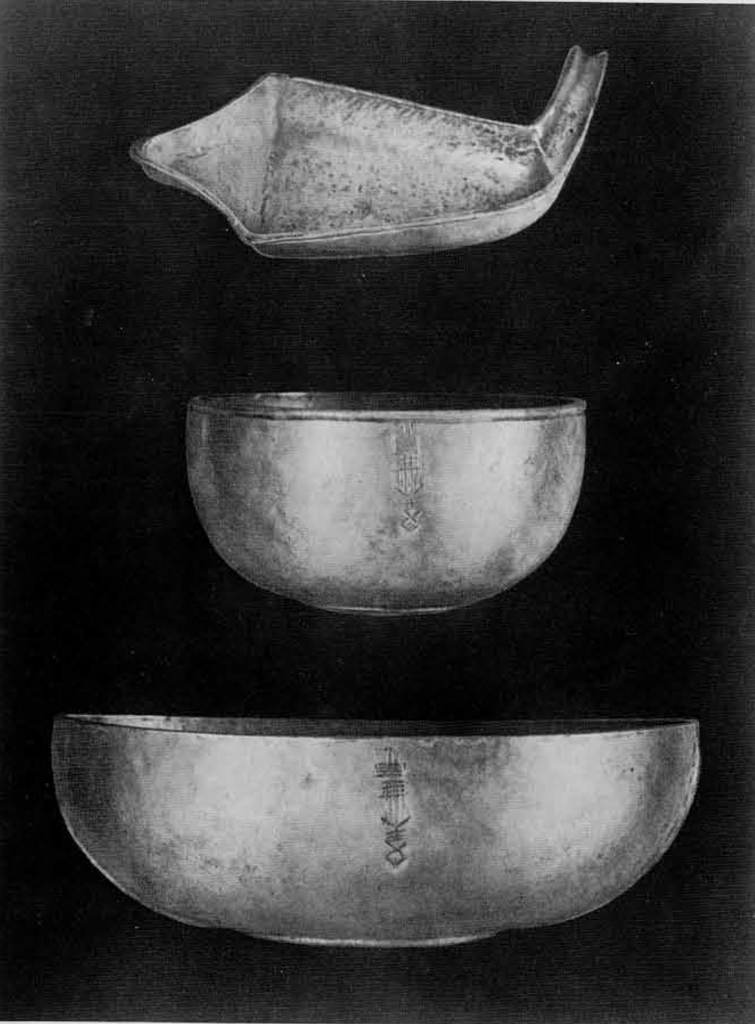
Museum Object Number(s): 29-22-8 / 29-22-5 / 29-22-6
Woolley classified as royal sixteen burials with a distinctive structure, a tomb-chamber of stone or mudbrick set at the base of a deep pit approached by a ramp, and with the simultaneous burial of household servants, male and female, with their master or mistress. As befitted royal burials, when they had not been plundered in antiquity, all such graves were found to be more richly equipped than the private graves. Although wheeled vehicles were found in some of the tomb-pits, Woolley himself did not press this as a criterion of royalty, though some scholars subsequently, notably Gordon Childe, did so.
Woolley always excluded from his group of sixteen royal tombs one of the richest graves of all, that numbered PG. 755, since it had neither human sacrifices nor distinctive structure. It was more like the hundreds of private graves which clustered round the royal tombs. They usually consisted of a shaft, from four to twelve feet deep, with the body rolled in matting or placed in a simple coffin of wood, basketry or baked clay. The body was provided with simple household vessels, tools, weapons and personal ornaments. The astonishing richness of PG. 755 and its inscribed metal vessels, to be examined below, have always challenged Woolley’s exclusion. Though there are persistent difficulties, as with everything in this cemetery, it seems perverse not to call it ‘royal’. It offers the most obvious stimulus to continuing discussion about the precise rank and role in Sumerian society of the individuals chosen for burial in tombs with human victims.
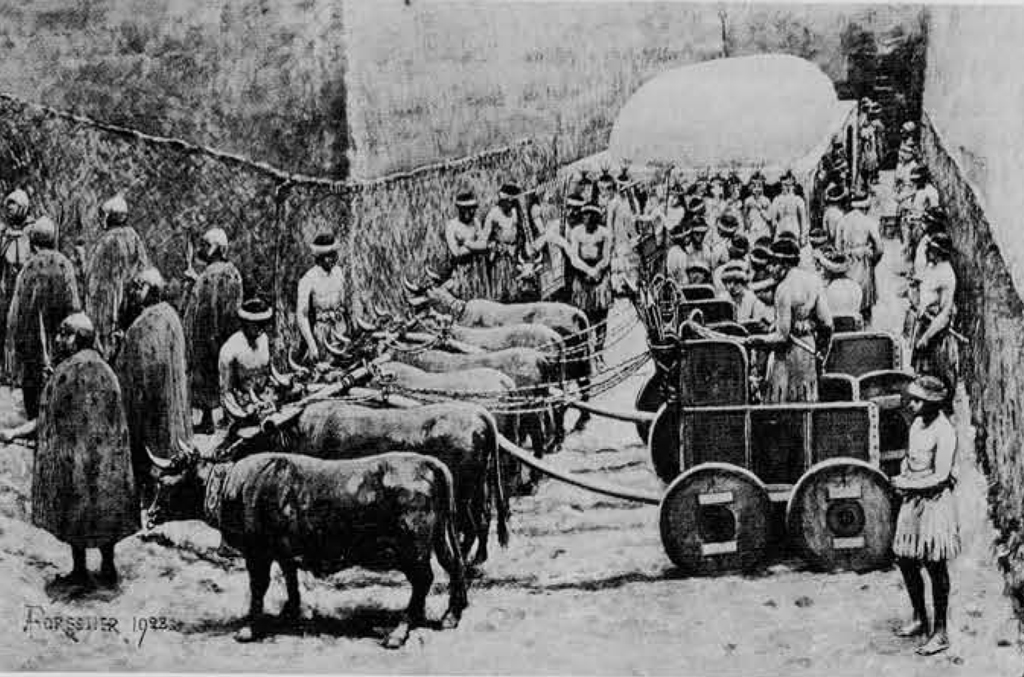

Museum Object Number(s): 87-28-8
Anyone fresh to the sixteen tombs taken by Woolley to be the graves of kings and queens of Ur in the middle of the third millennium B.C. will be struck first by the remarkably small amount of textual evidence for such a description. This discrepancy may not be wholly explained away by pointing out that these burials belong to an early stage in the use of writing for records. Such evidence as there is in these graves is provided by names, and occasionally titles, inscribed on cylinder seals: the distinctive form of seal rolled on clay by the Sumerians as a property mark or as a signature, for virtually all save the scribes were illiterate.
Royal grave 580 had associated with it a cylinder seal inscribed for He-kun-sig, a priestess of Pabilsag. In RT. 779 there was a seal for a man named E-zi, without a title; though the same name is that of a scribe on a seal in a private grave. The famous burial RT. 800 with a female primary skeleton produced three inscribed seals. That found in the tomb chamber is inscribed for Pu-abi (formerly read Shubad) with the title ‘nin; at Ur at this time this is normally taken as the feminine equivalent of ‘lugal. When applied to deities they are now translated as lady’ and ‘lord’; when applied to mortals, ‘queen’ and ‘king’, though a king’s wife was not necessarily honoured with the title ‘queen’, and those who did hold it continued to do so after their husband’s death. In Pu-ubi’s case it is now almost always rendered as ‘queen’, though the name of her husband remains unknown. Woolley took the name of one of the untitled people mentioned on a seal found in her tomb-pit, A-bara-ge, to be royal and a king, husband indeed of Pu-abi. This man, he believed, was buried in grave RT. 789, which had been contiguous to hers; but from which the body in the tomb chamber had disappeared in antiquity. The validity of this identification is questioned later. It was also argued originally that the other individual named on a seal found in the pit of RT. 800 was a male member of the royal family; but his name Lugalsa-pa-da is not necessarily a royal one. One of the most important of all the inscribed seals from the royal tombs was found without an associated body in RT. 1050. It is the only one from these graves to mention both a king and his wife, who does not have the title ‘nin’. This inscription has been read to mean either `A-kalam-dug, King (fugal) of Ur: A-su sikildigir(ak) is his wife’ or `To A., king of Ur, A., his wife, has dedicated this seal’. A wooden box in the upper levels of burial RT. 1054 had held two gold daggers before it rotted away and a seal inscribed for a man named Mes-kalam-dug with the title ‘legal’, but without specific reference to Ur. The only other royal tomb to provide us with inscribed seals was number RT. 1236; but neither, as has sometimes been assumed in the past, need be named for a royal person. Both individuals are untitled: one (A-anzu/A-Imdugud) has been taken by some scholars as the name of the tomb’s owner. None of Woolley’s royal burials contained inscribed weapons or vessels, although such dedicatory inscriptions were already current in Sumer. Their absence is made more conspicuous when attention is turned again to the remarkable private grave 755 (figure 10).

In this magnificently equipped burial were one copper and three gold vessels inscribed for a man named Mes-kalam-dug without a title. In all he wrote Woolley assumed that this man was quite different from the king of the same name whose cylinder seal had been placed in RT. 1054. Sadly the seal worn at his belt by the man Mes-kalam-dug in grave PG. 755 is too damaged to decipher. Sir Arthur Keith, who reported for Woolley on the skeleton in PG. 755, described him as “a strongly built, powerful man about 5ft. 5″ to 5ft. 6″ (1.6501.675 metres) in height . . . He was under thirty years of age at the time of death.” Without any compelling evidence to the contrary it is much simpler, indeed more reasonable, to follow those scholars who have taken them to be one and the same man. All the more so when this grave PG. 755 also contained at least one copper vessel inscribed for a certain Nin-banda, with the title ‘nin’, widely assumed to be Mes-kalmn-dug’s own queen. A ruler of Ur, A-ane-pada, not very much later, has left us inscriptions in which he is named with and without the title `Iugal’ and it has not been argued that this involves two men of the same name.
The tomb of the untitled Mes-kalam-dug was cut down into the shaft of royal tomb 779, which must therefore be earlier than it is. Although rather larger than the normal private graves, it was still just a pit only big enough to take a wooden coffin and leave some space on three sides for offerings, It is the quality of their workmanship and the luxury materials employed for them that put this grave in a class by itself—neither a conventional private grave nor, on Woolley’s criteria, a royal one. Outside the coffin fine weapons and vessels of baked clay, silver, copper and stone abounded. Within the coffin lay a male skeleton, distinguished above all by the now renowned gold helmet lying just to one side of the skull. In fact, in the ordinary sense of the word, this is not a helmet, but rather a magnificent copy of hammered and chased sheet gold of a Sumerian man’s hair-style, with a prominent bun at the back of the head. No less splendid was his personal equipment:
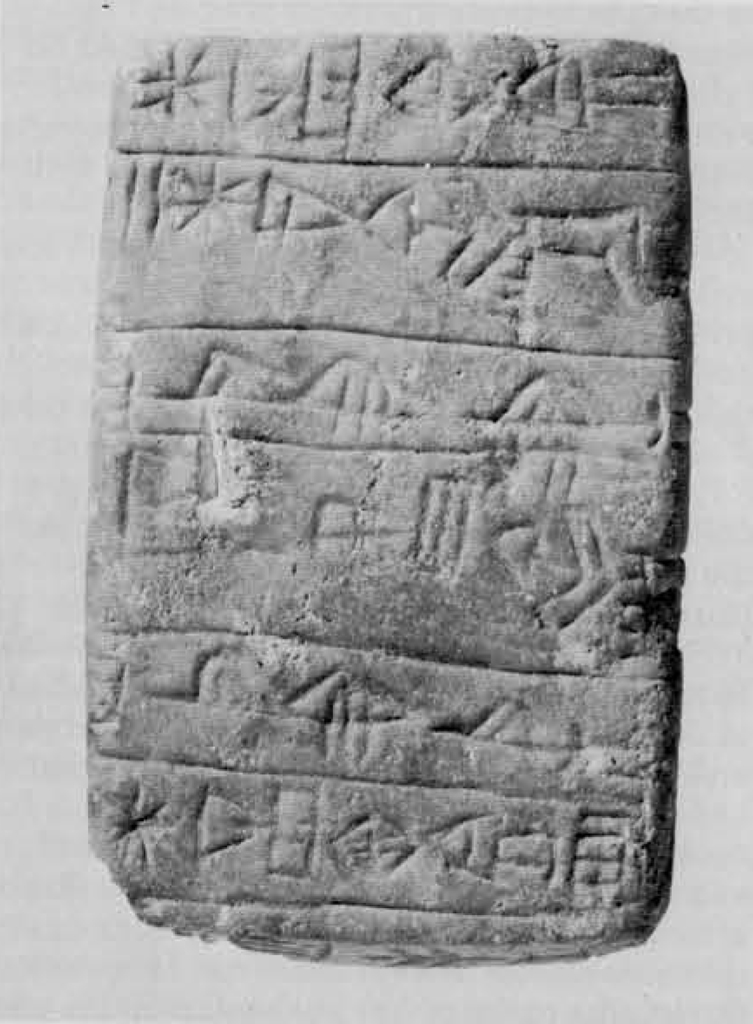
“a silver belt …; from it were suspended a dagger . .. the blade was of gold, the guard of gold studded with gold studs, the grip and pommel of silver plated over wood . . . the sheath was of silver … a whetstone of lapis-lazuli . .. a shell cylinder seal in very bad condition . . . a toilet reticule.” Hereabouts also were two electrum axeheads and the inscribed gold vessels already cited. Most curious of all, following Woolley’s description, was “a collection of jewellery which not only was not on the body but much of it was quite unsuited to it, being of the sort carried only by women; there were no human bones here, and it was not a case of secondary interment or of such human sacrifice as is found in the tombs of kings, but simply of offerings, presumably made by a woman.” Woolley’s conclusion introduces an appropriate intimate touch, particularly in view of the copper vessel inscribed for Nin-banda, titled ‘nin’, also in the grave; but it may not tell all. It is commonly assumed that the objects placed in these graves were for the use of the occupant in the hereafter. Such indeed may have been part of the intention. However, there is Sumerian literary evidence to show that some gifts were purposefully offered to placate the numerous deities of the Underworld in the interests of the dead man or woman. A text relating to the death of a later Sumerian king of Ur, Ur-Nammu (ca 2113-2096 B.C.), tells of him in the netherworld presenting vessels and weapons, garments and jewellery to its gods. Nanna, patron god of the city of Ur, was among the deities who traditionally decreed the fate of the dead.
This anomalous grave raises many questions. If there is good reason to think Mes-kalam-dug was indeed the ‘Iugal of this name, why is there no tomb-chamber or human sacrifices if these really were a necessary part of royal burials at Ur at this time? Does it mean that not all Early Dynastic kings of Ur were given such burials and, if not, why not? Might it be that kings of Ur were only rarely offered such human sacrifices and, if so, in what circumstances? What is the seal of Mes-kalam-dug doing in the grave of a lady, 1054, although there is nothing in that grave to indicate she is Nin-banda? Were the women in these graves invariably royal wives, or was there some other rank among the royal ladies that entitled them to burial with victims?
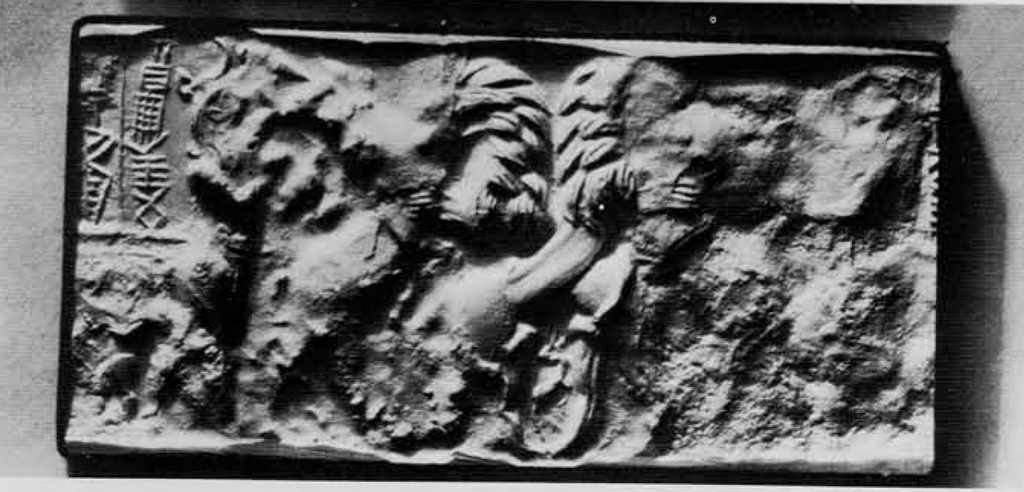
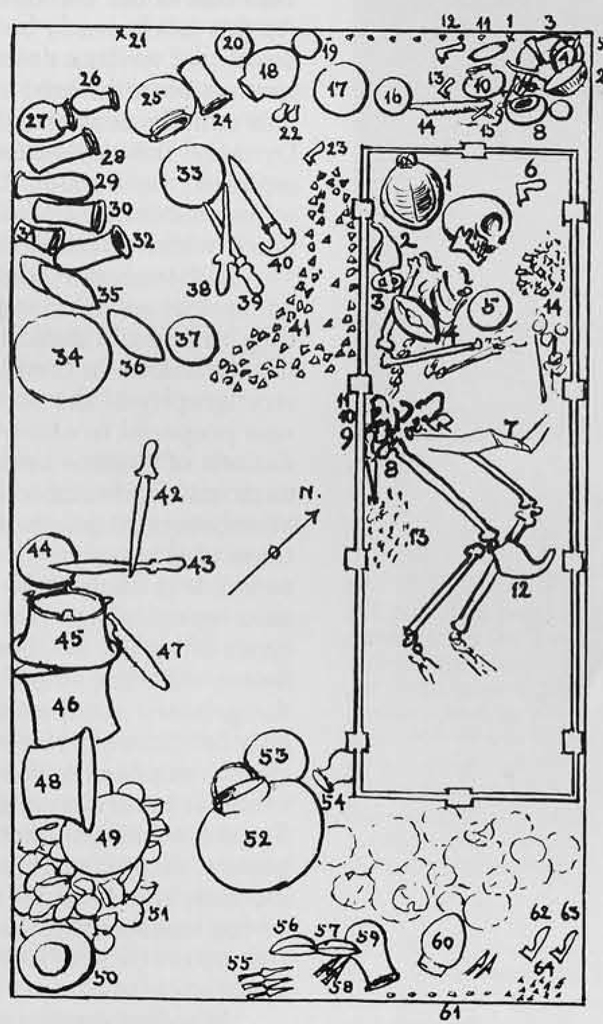
One of the more immediate and obvious ways out of this quandary would be to argue that grave PG. 755 was late in the series and that by then female ornaments were thought sufficient substitute for the actual human victim. Apart from the fact that there is some slight evidence for the persistence of human sacrifices in the later mausolea of the kings of the IIIrd Dynasty of Ur five hundred years later, the internal dating of the Early Dynastic IIIA royal tombs does not favour an easy chronological explanation. Professor Nissen in a searching reconsideration of Woolley’s excavations ten years ago showed that both the stratigraphy of the site and the cylinder seals found in the graves, as the most precisely datable objects, indicated that the sixteen royal graves did not lie very far apart
in time. As Woolley and others had always argued, Nissen believed they were indeed sealed by, and therefore earlier than, S.I.S. 2-1 containing inscriptions of the ‘First Dynasty of Ur’, notably of King Mes-ane-pada and his wife, Ninbanda. It is hard to sustain on chronological grounds the ingenious and attractive suggestion of Professor Hallo that this is the same lady who is named in grave PG. 755. Some have thought that this may be as much a title (‘junior queen’) as it is a personal name. Mes-ane-pada is known from Sumerian historical records as the founder of the ‘First Dynasty of Ur’. Nissen suggested that those few royal tombs that might be placed in a relative sequence with the available stratigraphical evidence ran from earliest to latest: RT. 1236-RT. 779-RT. 1054 (Mes-kalam-dug’s seal)-RT. 1050 (A-kalam-dug’s seal). On my arguments PG. 755 would fall just after RT. 1054, for A-kalam-dug, to judge only by the form of his name, was Mes-kalam-dug’s son.
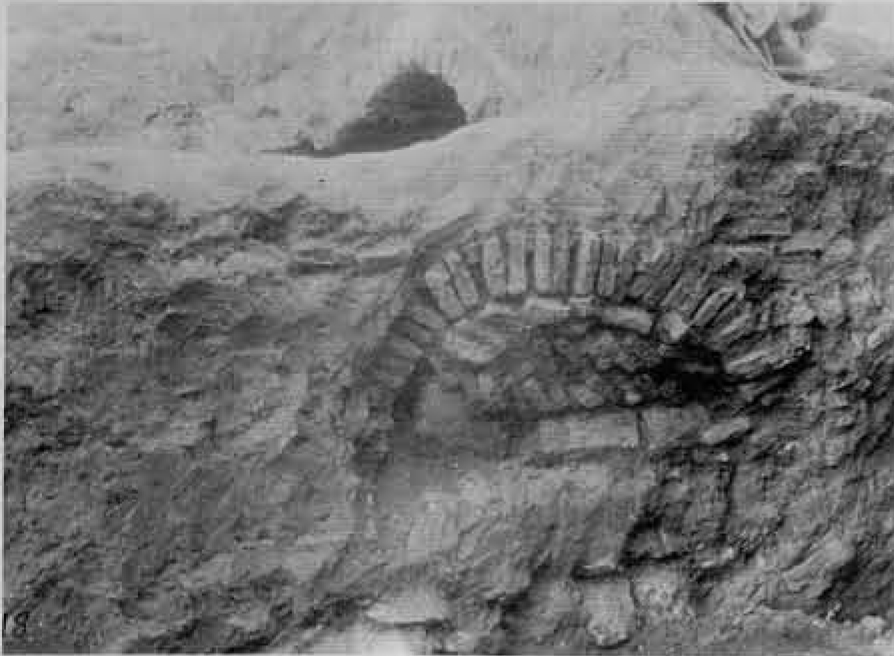
Neither of these men appears in surviving versions of the standard Sumerian King List. As this is known to be a selectively edited document written down centuries later, this has not been thought an insuperable problem. It is usually assumed that until the ‘First Dynasty’ the city’s rulers did not exercise authority far outside Ur, for it is known from other sources that Mes-ane-pada had a very much wider political authority over Sumer.
Although the exceptional grave of Mes-kulam-dug raises many still open questions, they should not surprise us when we consider the variations in the plans and vertical stratigraphy of the sixteen graves Woolley was prepared to accept as royal. The depredations of thieves in antiquity and the destruction of tomb chambers in the digging of subsequent graves are only partial explanations of this variety. Nor, as has already been noted, is it likely to be explained by significant lapses of time between the differing types of burial. Do these differences then betray differing social or religious roles among the primary occupants? The contrasts will only be cursorily reviewed here to define as clearly as possible the main distinctions. But even the most casual glance at the plan on figure 3 will show that certain structural groups, also to some extent topographically distinct, stand out when the graves with surviving tomb-chambers are considered: RTs. 789/800; 777/779/1236; 1050/1054; and 1618/1631/1648.
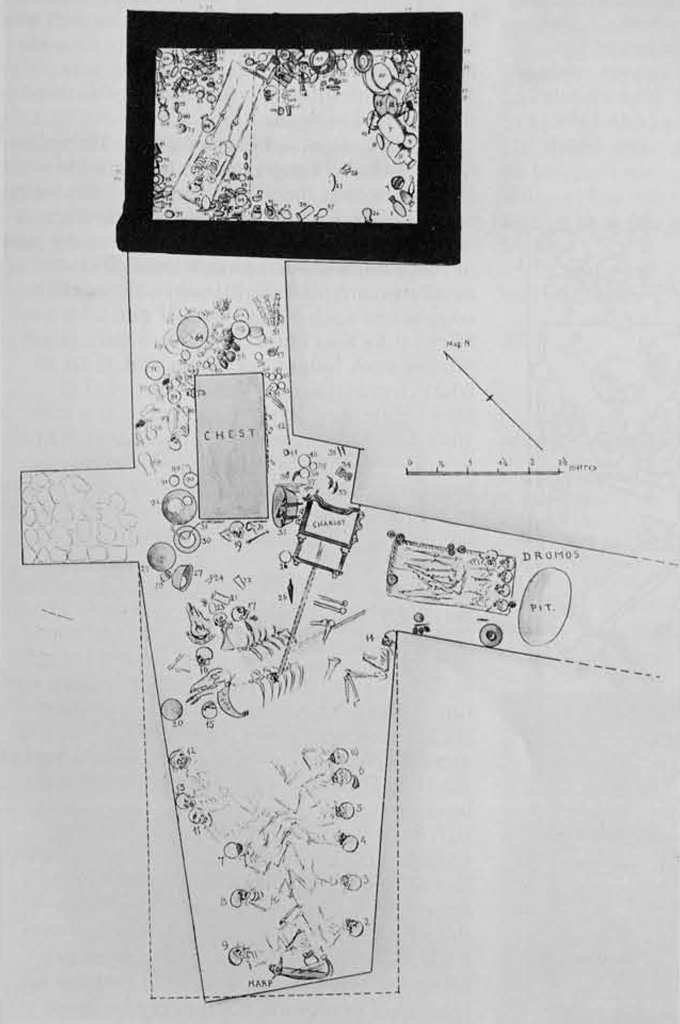
Woolley’s primary criteria of a deep pit with sloping ramp, down which the vehicles and attendants entered the grave, applied best to the related royal tombs 789/800, whose adjacent tomb chambers and overlapping pits Woolley so skilfully unravelled (figure 7). The association of Pu-abi’s seal and the primary female burial in RT. 800 make it the most reliably identified of all the royal tombs. Woolley’s inferences about the adjoining RT. 789 were ingenious “. . whereas the former (i.e. 789) was all on one plane, the queen’s tomb-chamber had been sunk below the general level of her grave pit. Probably they were husband and wife: the king had died first and been buried and it had been the queen’s wish to lie as close to him as might be; for this end the grave-diggers had re-opened the king’s shaft, going down in it until the top of the chamber vault appeared; then they had stopped work in the main shaft but had dug down at the back of the chamber a pit in which the queen’s tomb could be built.” It was then Woolley believed that the king’s grave had been broken into and ravaged—an act of desecration deliberately concealed by placing “the great clothes-chest of the queen over the hole to hide their sacrilege.” In this he may have been influenced by famous cases in ancient Egypt, not least that involving the grave of Queen Hetepheres (ca 2650 B.C.) found by Reisner in 1925. Woolley’s description of this tomb chamber as plundered is convincing; far more so than Professor Moortgat’s contention that it was intentionally cleared of the body as part of a death and resurrection ritual associating these tombs with the nature god Tammuz and his cult. His reconstruction of this cult is in itself now no longer accepted.
There is no such clear way out of the problem. Without either a primary body or an inscribed seal in RT. 789 we shall never know whose burial this was. Nor may we be absolutely certain that this was a male primary burial, though the two wheeled vehicles in the tomb pit, rather than the land sledge left for Pu-abi, suggest it. Woolley’s identification of the owner of the tomb as a king A-bara-ge is based on very questionable assumptions about an inscribed lapis lazuli cylinder seal found loose in the pit of Pu-abi’s grave. It is decorated with banquet scenes in two registers, just as is her inscribed seal, and it might well be another of hers, or an attribute of one of her ladies-in-waiting, for the name could well be female. By contrast, the cylinder seal inscribed for one Lugal-sa-pa-da, found with one of the grooms in Pu-abi’s tomb-pit, is carved with an animal contest scene, like those of other seals for men in the royal tombs.
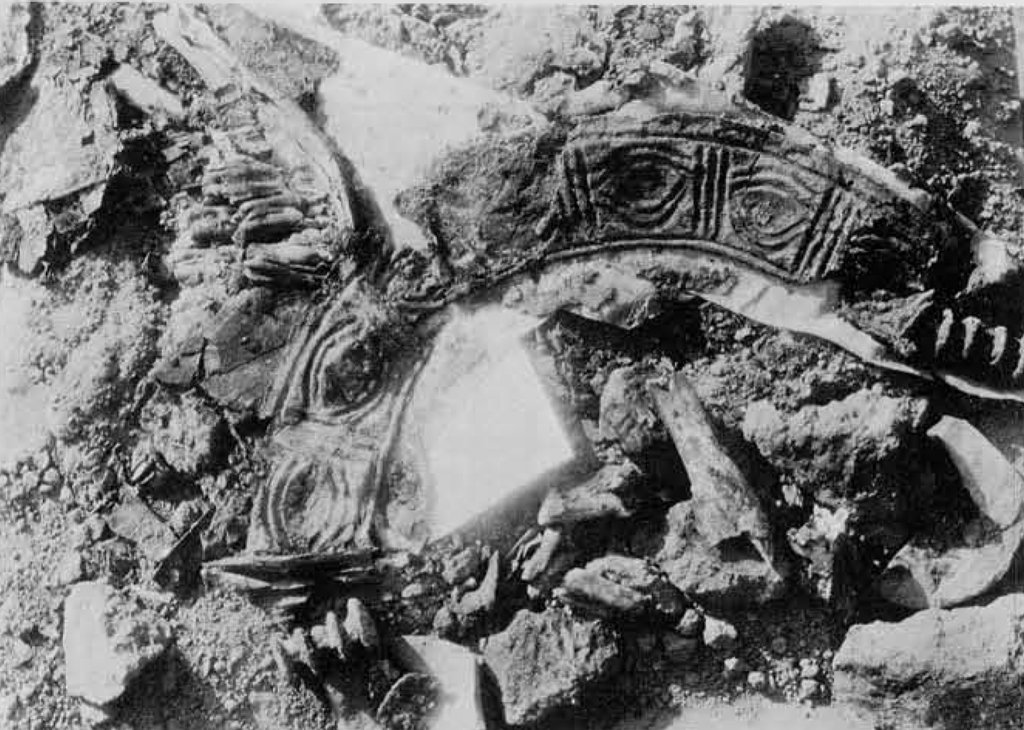
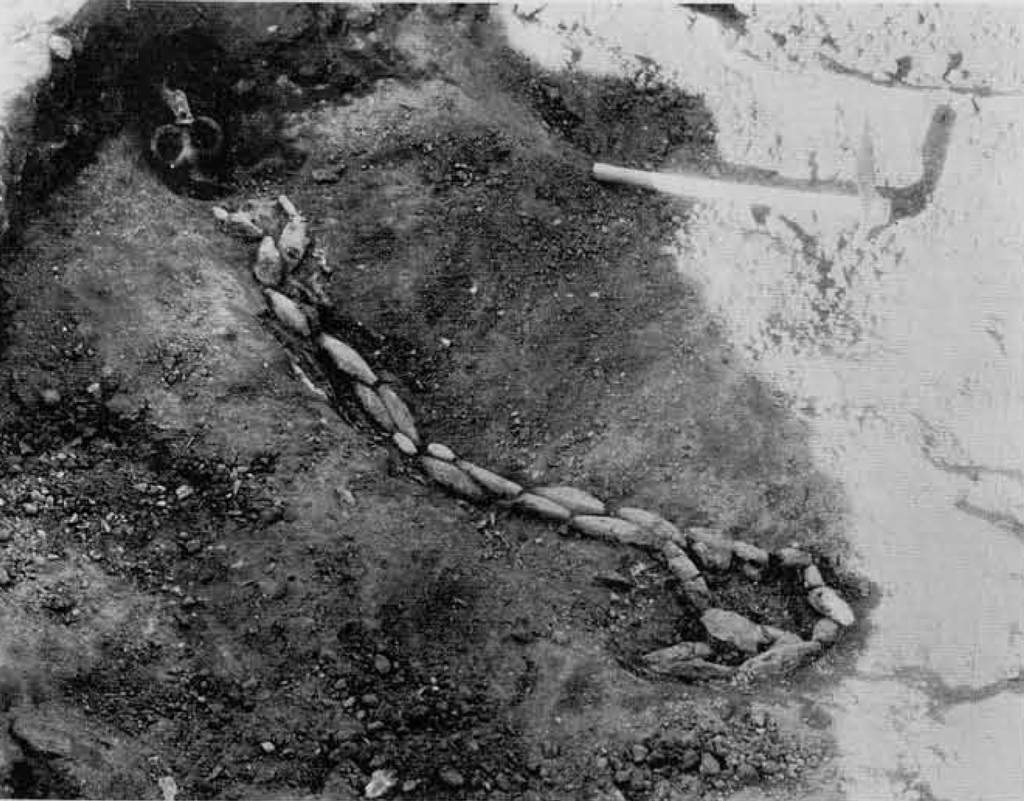
The three royal tombs 777, 779 and 1236 are linked by their plan. In them the tomb chamber had been elaborated into a structure with more than one room either made with a simple partition as in RT. 777, which was much ruined, or actually designed as a multiple unit as was the case with RTs. 779 and 1236. In these graves it would appear that one room was set aside for the primary burial, whilst members of the household occupied the outer rooms rather than lying in an open death-pit as in RT. 789/800. One of these graves, RT. 777, to judge by the jewellery left in the plundered primary burial, had been for a woman. RT. 779 offered no definite clues. On the evidence of two inscribed seals already considered, RT. 1236 has been taken for the grave of a king; but these seals alone will not sustain that conclusion.
It was from RT. 1054, more than from any other royal graves, that Woolley gained information allowing him to reconstruct the stages in the rituals which had accompanied these burials, though in form and contents it was often very different from RT. 789/800. High in the shaft, originally Woolley assumed within a vaulted chamber, was a wooden box containing two daggers and a seal inscribed for Mes-kalam-dug as Iugal, decorated with an animal contest scene. Next to this was the body of a man in a wooden coffin; in Woolley’s words: “the furniture with it was by no means of the type which one would expect with a royal person.” (figure 16) Beneath was a succession of clay floors with offerings in clay vessels and simple subsidiary burials, which Woolley associated directly with a stone-vaulted primary burial beneath them. The final stages of the excavation here are vividly recounted by Woolley: “The stone blocking of the door was pulled away, and inside, beneath the remains of rotten wood fallen from the ceiling, lay five bodies, four of them those of men—servants, judging from their poor equipment—and the fifth was that of a woman; she had the golden headdress of one of high rank, a long curved golden pin such as we had not seen before fastened her cloak, in her hands was a fluted and engraved tumbler of gold, and by her side a golden cylinder seal, the first we have ever found: this clearly was a queen.” (figure 19) The seal is uninscribed, though decorated with banqueting scenes in two registers, just like that of Pu-abi. Woolley believed that Mes-kalam-dug’s seal was here in the upper filling as a dedication to the queen. But if it was his queen, or a queen of one of his predecessors, why was she offered human sacrifices, whilst he, following my earlier argument about PG. 755, went without them? Is it possible that this royal lady merited them by virtue of an office other than that of queen at Ur?
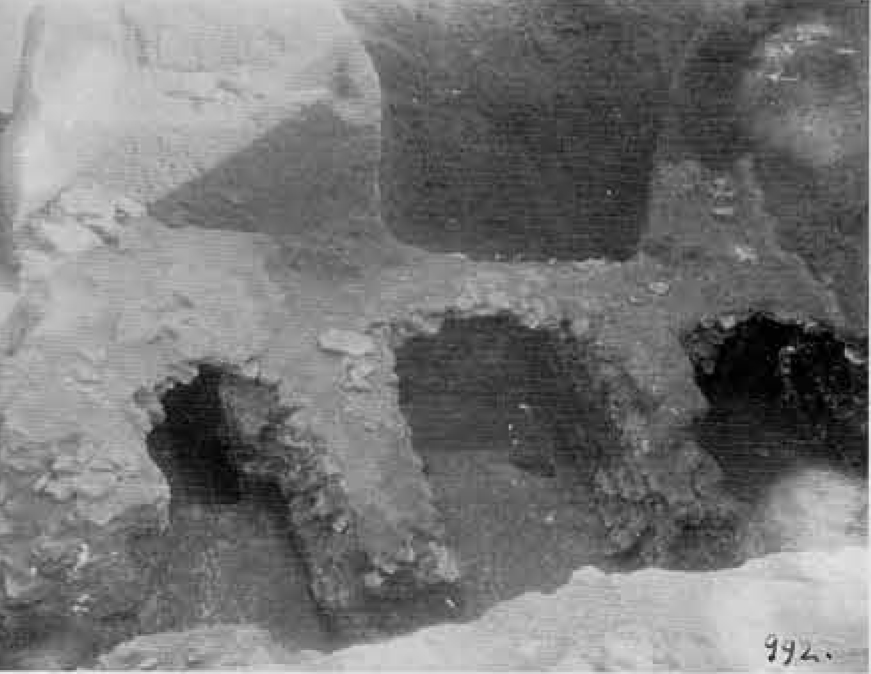
It is very much to be regretted that the closely comparable tomb RT. 1050 was so badly plundered. The tomb chamber has been so ravaged that it was not clear what the sex of the primary burial had been. It was here that the cylinder seal with the names of A-kalam-dug and his wife, the only cylinder seal found in the grave, lay loose on the floor. In only one striking respect was this burial different from RT. 1054. Here, below the tomb chamber, was a death-pit containing forty bodies: “None of these forty attendants was richly dressed, many had no objects or ornaments at all . .. One broken ostrich-shell, a few shallow bowls of white limestone, and a few copper weapons completed the furniture of this very poor `death-pit’.” Such was Woolley’s verdict. In view of the role played by Mes-kalam-dug’s seal in the woman’s grave RT. 1054, we may not automatically conclude that RT. 1050 is identified as the grave of A-kalam-dug through his seal.
Different again were the three male burials towards the southwest corner of the Royal Cemetery numbered as RTs. 1618, 1631 and 1648. These were very similar simple tombs with a chamber, small pit and human sacrifices. They were all graves markedly smaller than the rest of the royal tombs and the furnishings were far from opulent. No cylinder seals were found in any of these graves and their stratigraphical position in relation to the other tombs is equivocal; but in so far as it goes we may agree with Woolley in thinking these the latest in the series of royal tombs. RT. 1618 is certainly later than RT. 1648, since it overlapped it, and Woolley observed that the gold fillet headdress in it was most often encountered in private graves of the later period. Were it not for the evidence of human sacrifices here, neither their form nor their contents would have distinguished these three graves as certainly ‘royal’. They are the only graves among the royal group at Ur that bear some resemblance to the ‘chariot-graves’ at Kish in central Iraq. The Kish graves are either contemporary or slightly earlier; but were so poorly excavated that certainty about their form is impossible. Although the furnishings were in no way as splendid as those at Ur, precious metals and semi-precious stones are virtually absent, there may have been secondary burials associated with a primary interment in some kind of tomb chamber set in a deep shaft. The presence of a wheeled vehicle calls for comparison, however, with RTs. 580, 789, and 1232 at Ur, rather than with these three graves which lacked any such elaborate furnishings.
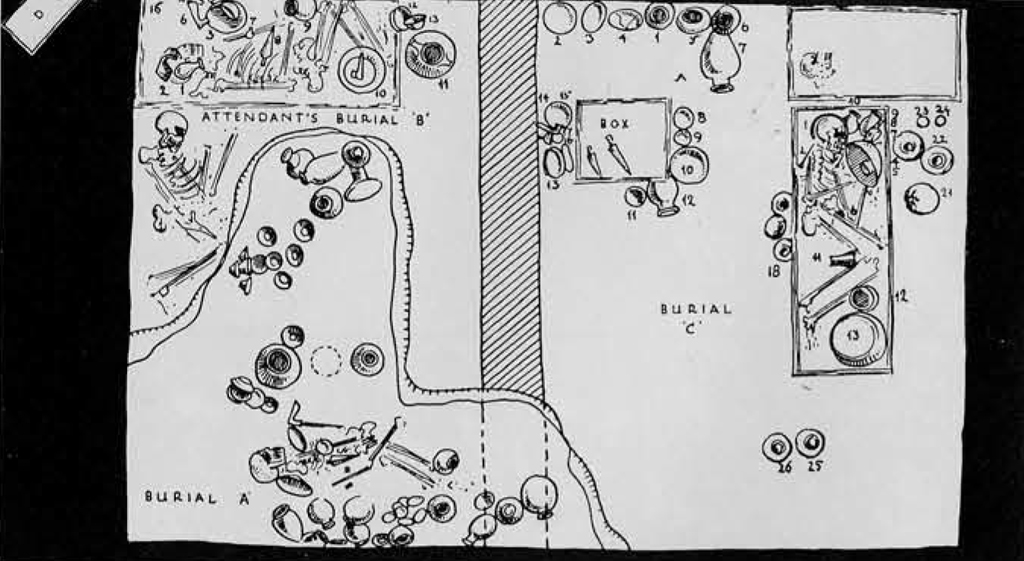
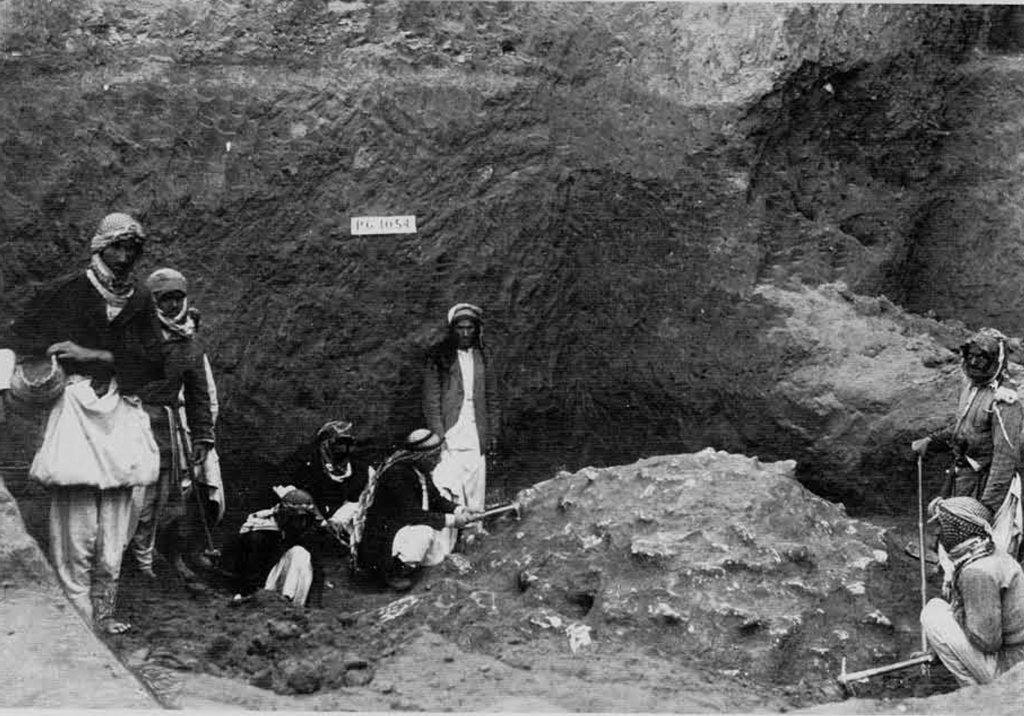
Another striking disparity in the royal tombs is to be found among the numbers, and proportions of the sexes, in the ranks of the victims. Here again, of course, the circumstances in which the evidence was recovered must be kept constantly in mind. The state of preservation of the skeletons was often very poor and the numbers given in Woolley’s reports are clearly on occasion minimal counts. Most crucial of all, and the single most significant gap in our evidence, we have no systematic scientific sex determinations for all the complete skeletons recorded. In the circumstances it was not possible and, even if it had been, there would have been considerable methodological problems. But, bearing all such reservations in mind, a rapid survey of the available figures is instructive in attempting to explain these graves. As some attention has already been paid to graves with surviving tomb chambers, a start will be made here with the ‘death-pits’, for that was where the victims were concentrated. In RT. 337 there were only 3 extant skeletons, whilst in RT. 580 only 3 oxen for drawing vehicles into the grave were located. In RT. 1157 there were 58 secondary skeletons. In RT. 1232 only vehicles, animals, a groom and a driver were found and, as Woolley indicated, this may indeed be part of the approach to RT. 1237 (“The Great Death-Pit”), Which held 6 male and 68 female victims. RT. 1332 had 23 skeletons in an upper level, 20 in a lower. Of the larger royal tombs where a chamber had survived, RT. 777 had 4 ‘soldiers’ in the approach, evidence for at least 4 bodies in the antechamber, and in the main chamber a primary burial, whose jewellery suggested a woman, with 3 attendants, one certainly male. RT. 799 had at least 9 surviving skeletons. In RT. 789, where the primary burial was missing, there were 63 bodies in the pit, whilst the adjacent RT. 800 had 2 attendants with the primary burial of Pu-abi and 21, mostly female, skeletons in the pit. RT. 1050 had at least 12 secondary skeletons in the upper levels; then a single secondary burial in a reed coffin, and below it a plundered primary burial above a death-pit with 40 skeletons. RT. 1054 had 4 secondary burials at the top and below them a primary female burial with 4 male attendants. In RT, 1236 no skeletons were traced. Of the smaller graves, all male, RT. 1631 had only the primary burial extant; whilst RT. 1618 had 4 victims and RT. 1648 1 male and 2 female secondary skeletons. Among the victims the large number of women, even with this irregular evidence, is clear and possibly a significant, if elusive, clue to the special nature of some of these burials,
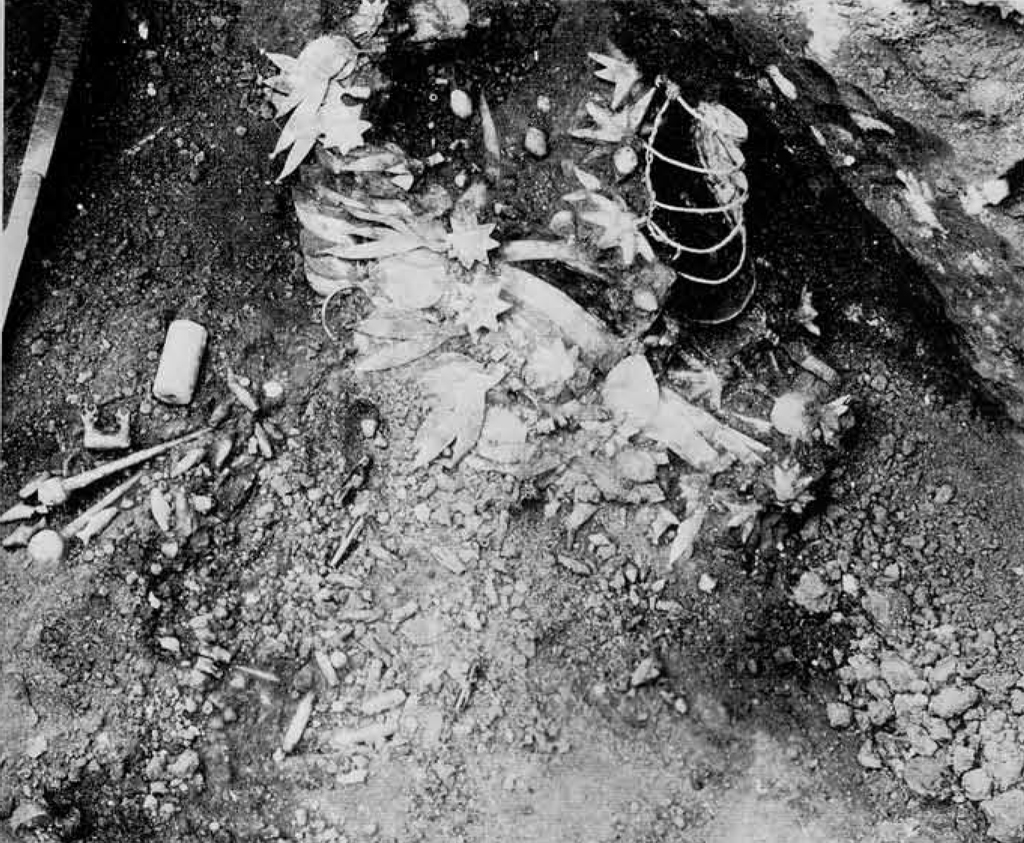
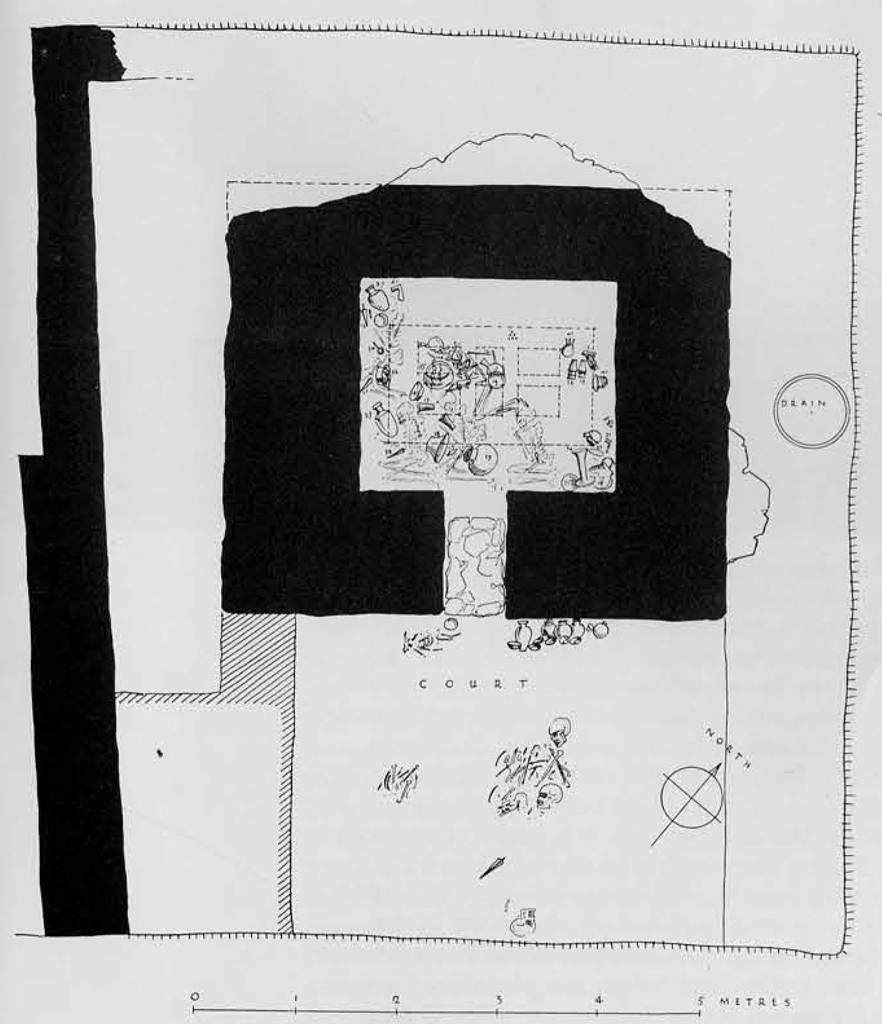
Before pursuing this point, taking in as it necessarily will more general aspects of Sumerian society, it is useful to have clearly in view what little we know about the rank and social role of the victims. In every case it seems to be only the immediate household staff of the buried dignitary. There is no evidence of children and no clear evidence of the self-immolation of wives at their husband’s funeral. Where men may be securely identified among the human victims they are usually either armed guards, grooms or charioteers; the women, nearly always with a set of elaborate personal ornaments, including what Woolley called the ‘gala’ headdress, are either just in attendance without equipment or occasionally provided with the lyres and harps that were among the most brilliantly excavated and restored of Woolley’s finds. The distinctions of rank and function appear to have been retained in the mustering of the household in those graves where they took their positions down the ramp and into the pit outside the tomb chamber, as in RTs. 789/800. Within the chambers it has been assumed that the secondary skeletons of men and women were valets and personal maids. In the Great Death-Pit (RT. 1237), in all probability part of a splendid female burial, the entrance was guarded by 6 armed men. All the bodies within the pit were female: 4 harpists with what was described as a ‘great copper basin’, perhaps a drum, and then 64 ladies-in-waiting lined up in orderly rows. They had all been attired in elaborate court dress with its splendid body jewellery and the now familiar bejewelled headdress worn in its most elaborate form by Pu-abi. The only marked distinction was between the 28 ladies with gold hair ribbons and the remainder with silver. The court as distinct from the personal household, that is the religious, military, and civil administrators in today’s terms, were buried as they died in the simpler graves that clustered, in timeless oriental fashion, as close to the tomb of their royal patron as possible.
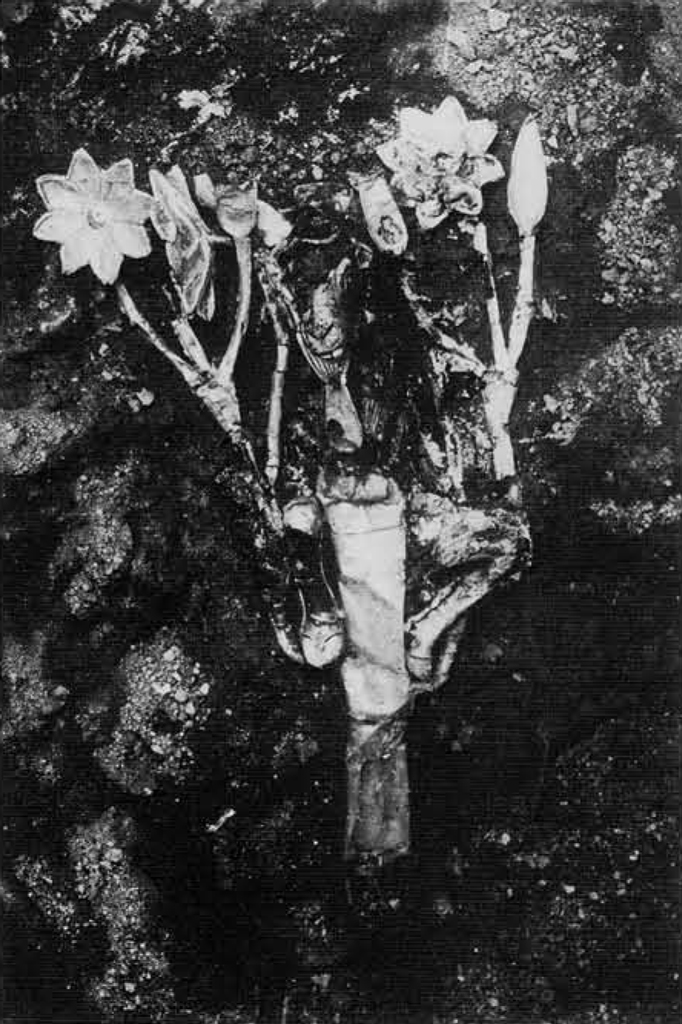
Museum Object Number(s): 30-12-702
The cylinder seals in the royal tombs have already been examined for the light their inscriptions throw on their owners. This by no means exhausts their interest for the present inquiry. It might be anticipated that differences in material, possibly even in size, and particularly in iconography, would indicate differences in social status or official function. Of the 29 legible cylinder seals published from royal graves, 2 are of gold over a core of some other material, 18 are of lapis lazuli, 7 of shell, 1 of shell with lapis-lazuli caps (Mes-kalam-dug) and 1 of calcite. A number of decayed shell cylinder seals were recorded with the victims in death-pit 1157. As has already been noticed, the gold seal in 1054 was with a primary female burial; the other, in 1236, was loose on the floor of chamber C. Neither was inscribed. The first was decorated with a banquet scene, the latter with an animal contest. With one exception, an unusual mythological scene in RT. 1054, all the seals from royal graves may be classified broadly as either ‘banquet’ or ‘contest’, which with minor variations is a distinction equally applicable to contemporary private graves. Within the royal tombs, to take the matter no further at this stage, we might suppose that this indicated either a distinction between the seals of men and women, or more probably, between an institution or institutions predominantly associated either with men or women. All four of the lapis seals in Pu-abi’s grave, including that bearing her name, feature banquets, as does the lapis seal of the priestess in RT. 580 and the gold seal of the lady in RT. 1054. In contrast, the seal of Mes-kalam-dug, the lapis seal of A-kalam-dug, and the gold seal in E.T. 1236 are decorated with contest scenes. So also is the seal of Lugal-sa-pa-da, found near one of Pu-abi’s grooms; but it is of shell. Of shell also, and decorated with contest scenes, is the seal inscribed for a man in RT. 1236; the other inscribed seal in this grave featured a banquet scene.
We might conclude that contest scenes in precious materials were the prerogative of kings and senior members of the royal family at this time, whilst the same scene in shell or calcite was the signature of lesser ranking male members of the household. In private graves there is some further correlation between shell cylinder seals cut with contest scenes and men buried with weapons. Over 50% of the ‘banquet’ seals, predominantly of lapis lazuli, dated to Early Dynastic IIIA, were in royal burials, whilst the fourteen private graves with such cylinder seals, judging only by equipment, it must be emphasized, are 9:5 in favour of women. Two of these private graves are of especial interest. PG. 1130 not only contained two lapis lazuli banquet seals close to the body but also, in addition to rich body jewellery, the remains of a harp exactly like that in Pu-abi’s grave which was, in Woolley’s words, “otherwise unique” (figure 25). PG. 1312 “is one of the very few graves (cf. PG. 755, the grave of Mes-kalm-dug) in which female ornaments are placed with a male body” (figure 28). Here it is clearly not sex so much as some relationship to an institution, primarily female, which distinguished the holders of ‘banquet’ seals.
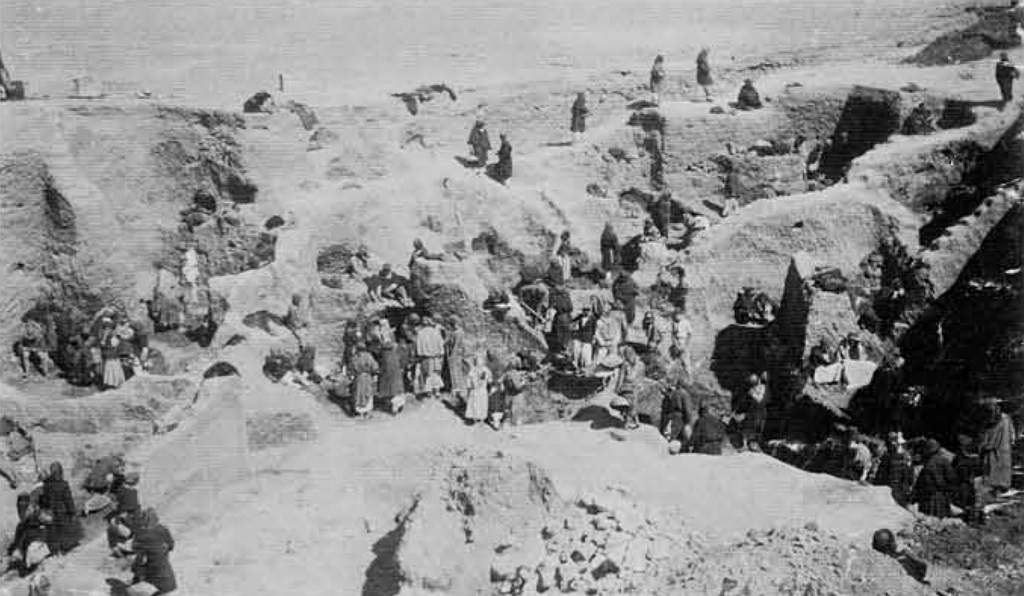
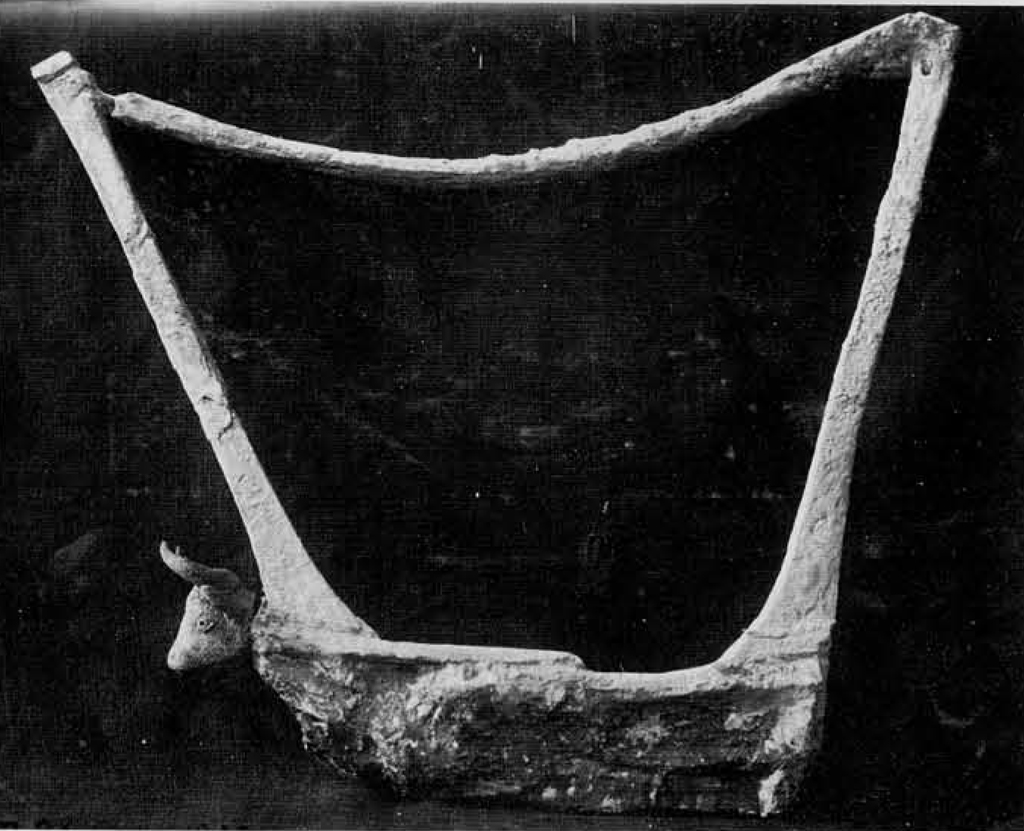
It is with some hesitation that I press this particular line of argument, since it depends so heavily on the hazards of archaeological discovery in a cemetery where they were notoriously fickle. But my main purpose here is to raise questions rather than resolve them. On the seal evidence, RT. 337 with a lapis banquet seal enters the female category, as does RT. 580, with the additionally persuasive evidence of an inscription for a priestess. RT. 777 had no seals; but the jewellery of the primary burial has already been cited as that of a woman. RT. 779, by contrast, with a lapis contest scene and three shell seals, one illegible and two cut with contest scenes, including an inscription for a man, would go into a male category. Woolley’s “King’s Grave” (RT. 789) by contrast, with a lapis contest scene and three shell seals, one illegible and two cut with contest scenes, including an inscription for a man, would go into a male category. Woolley’s “King’s Grave” (RT. 789) has a lapis seal with a banquet scene and another with an animal contest in the upper register, a banquet in the lower, neatly compromising my dichotomy in iconography. As we have already seen, the weight of evidence favours a male burial. Pu-abi’s grave (RT. 800) has already been considered. The lapis seal of A-kalam-dug in RT. 1050 has a contest scene; as does the seal of Mes-kalam-dug, lugal, in RT. 1054. This grave also yielded an uninscribed seal cut with animals, real and imaginary, set in two registers. RT. 1236 we have already assessed. In RT. 1237, where the victims suggest a major female burial, there were two lapis seals cut in a style earlier than that of the royal graves, one a contest, one a banquet, scene. There were in addition one calcite and three lapis banquet seals. The reading of an inscribed one as dumu kisal, rendered as ‘daughter of the court’, is too uncertain to be brought in here as evidence, though it would be very relevant. RT. 1332 held a lapis banquet seal and may well be another female grave. The male skeletons of RT. 1618, 1631 and 1648 produced no seals; nor did the death-pit 1232, which may be part of 1237. No legible seals were published from RT. 1157.
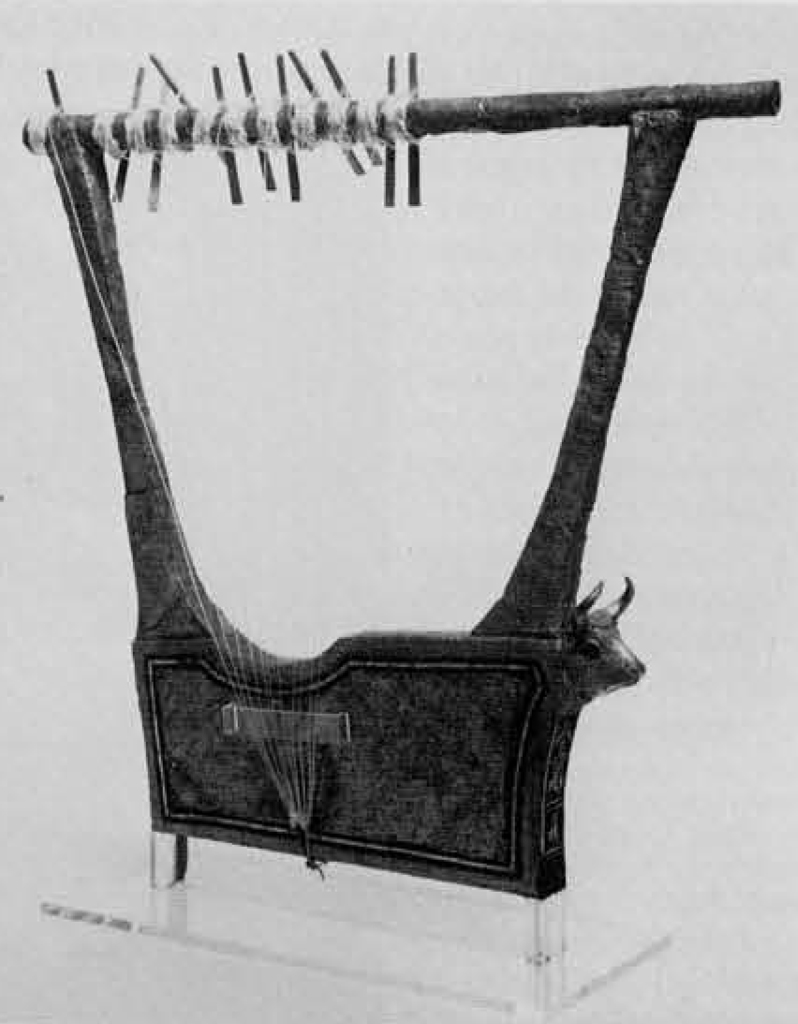
When Woolley published these royal burials there was no Sumerian literary or historical evidence to corroborate the view that human sacrifices had accompanied the burials of Sumerian rulers and their wives. There is still no compelling evidence in Sumero-Babylonian tradition that human victims were in the strict sense of the word ‘sacrificed’ either to deities or to the spirits of divine or semi-divine kings and queens. ‘Self-immolation’ is anyway probably a more exact description of what Woolley found, for it suggests, as ‘sacrifice’ need not, the wish of the victims to continue to serve in the household of their master and mistress in the hereafter. But there are now one or two pieces of evidence from texts that must be taken into account in discussing Ur’s royal tombs.
Each Sumerian city was believed to belong to the god to whom it had been assigned at creation. The temple, his residence, dominated the city with its richly furnished shrines, offices, workshops, storerooms, kitchens and conspicuous staged-tower (ziggurat). By the time of the Early Dynastic III royal tombs at Ur in the middle of the third millennium B.C. political power was exercised in the city-god’s name by a man, known in Ur as the `Iugal’, who in modern terms combined the offices of chief priest, justiciar, war leader and prime minister. He lived close by, though not in, the temple, save perhaps during special annual festivals. The city of Ur belonged to the moongod Nanna, whose high priestess, when records are available, was always of the blood royal, usually a sister or daughter of the ruling king. She was believed to be elected by the god, who revealed his choice to the people through omens. She served for a specific length of time and then retired, rather than holding the office until death. She had an official residence, the giparu, on the temple platform at Ur. Texts indicate that she served as the human wife of the god Nanna, representing his divine wife Ningal, in any rites. There is sparse archaeological evidence for the existence of the giparu already in the Early Dynastic period; but there is no inscriptional evidence of this time certainly naming a high-priestess of Nanna.
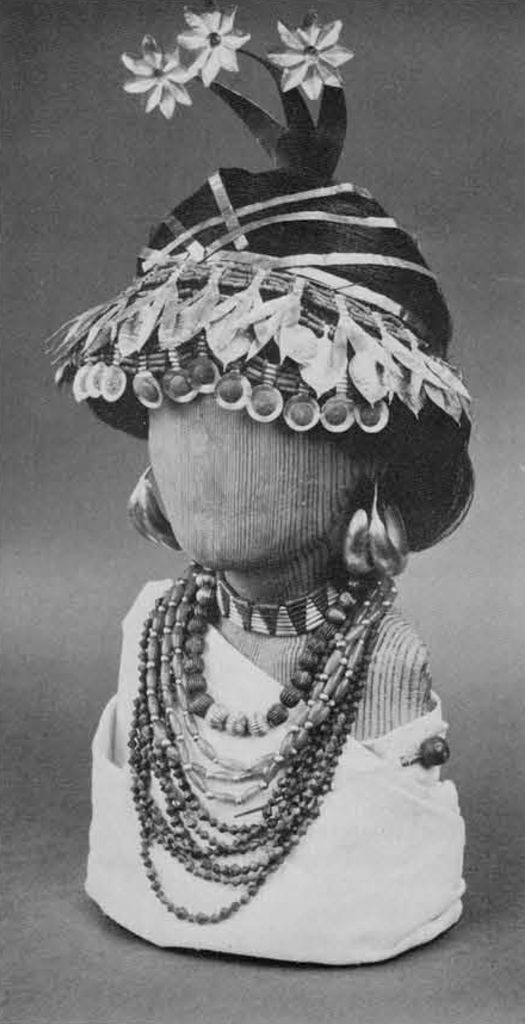
The earliest securely recorded holder of this office is Enheduanna, daughter of Sargon of Akkad, who calls herself ‘wife of Nanna’. Since her father, from Kish, had made himself ruler over Ur by conquest about 2300 B.C., it is likely that in appointing his daughter he was following an already time-honored Sumerian practice that brought with it legitimate religious and political authority in the city.
The lady Enheduanna was an accomplished poetess, of whose works a long prayer to the goddess Inanna, daughter of Nanna, and a collection of hymns to the various major temples of Babylonia have survived. Her prayer, now known as “The Exaltation of Inanna,” contains an enigmatic passage relevant to our present inquiry. In cursing a usurper in the city of Uruk, who threatened the rule there of her nephew King Naram-Sin (ca 2254-2218 B.C.), the high-priestess wrote, addressing Inanna, in Professor W. W. Hallo’s translation:
“In the place of sustenance what am I, even I?
(Uruk) is a malevolent rebel against your
Nanna may An make it surrender! This city— may it be sundered by An! May it be cursed by Enlil!
May its plaintive child not be placated by his mother!
Oh lady, the (harp of) mourning is placed on the ground.
One had verily beached your ship of mourning on a hostile shore.
At (the sound of) my sacred song they are ready to die.”
The translator has made the suggestion that the final line here might be an allusion to the ritual of burial involving a whole retinue together with a ‘queen’ or high-priestess, as found by Woolley. The imagery of the previous two lines could also be taken as a reminiscence of the musical instruments found with the ladies in the death-pits, and the model boats which were found in some of the tomb chambers. There were silver and copper model boats in RT. 789 and two of bitumen in RT. 580, as in some private graves. Significantly perhaps later copies of this stanza replaced ‘they are’ in the final line with ‘I am’, possibly misunderstanding an allusion to a custom by then long forgotten though in Enheduanna’s time it would still have been a living memory at Ur, if no longer practised under her new Semitic Akkadian kings. Care, however, is needed at Ur in making distinctions between Sumerians and Semitic-speaking Akkadians at the time of the royal graves. The name Pu-abi is Semitic and not long after her the wife of a ruler of the ‘First Dynasty of Ur’ dedicated to him a calcite bowl in an inscription which is the oldest text in a Semitic language so far reported from southern Mesopotamia.
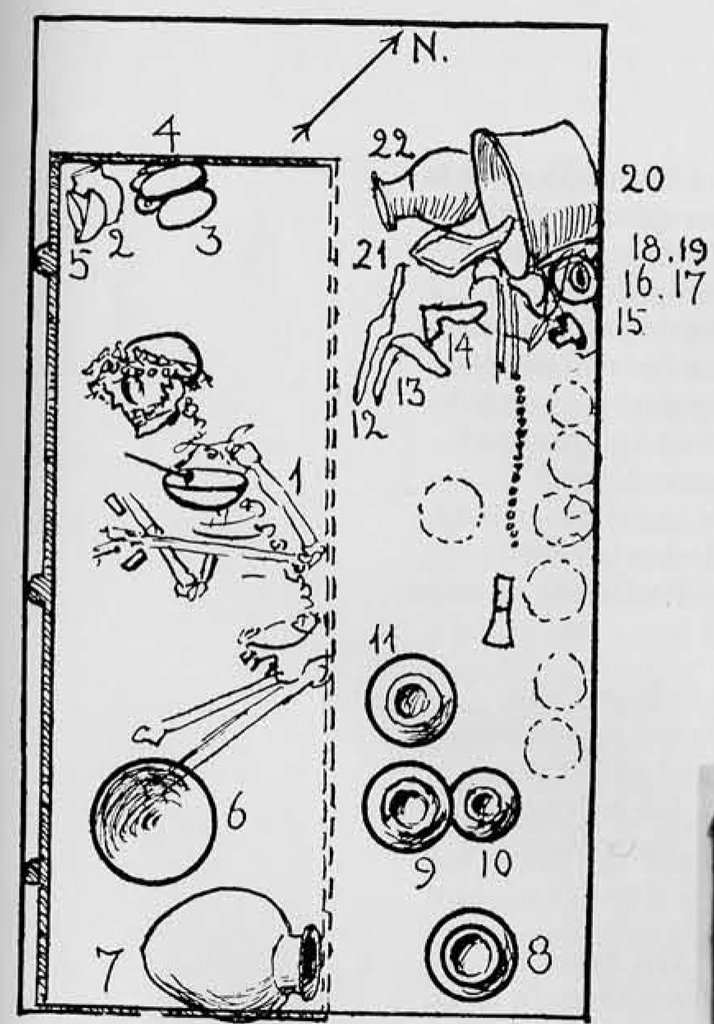
Before too readily assuming that some the female burials at Ur were for priestesses rather than for queens in the modern sense, attention needs to be paid to a fragment of the Sumerian ‘Epic of Gilgamesh’, first published by Professor S. N. Kramer in 1944 It may describe a royal male burial with attendant human sacrifices. Professor Kram translates:
“His beloved wife, his beloved son, The …—wife, his beloved concubine, His musician, his beloved entertainer. His beloved chief valet, his beloved His beloved household, the palace attendants,
His beloved caretaker,
The purified palace . . . the heart of Erech—whoever lay with him in that place,
Gilgamesh, the son of Ninsun, Weighed out their offerings to Ereshkigal,”
—then follows a long list of underworld deities before the text finally breaks off.
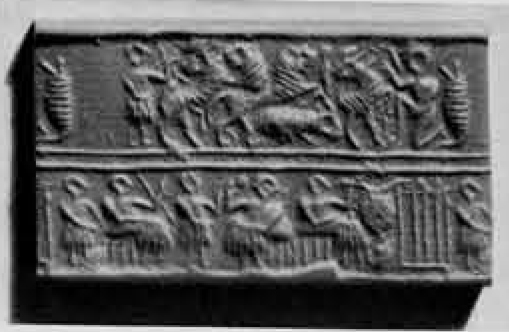
Gilgamesh was an historical figure, ruler of the city of Uruk (Erech) about sixty kilometres to the northwest of Ur, about the time of the royal tombs at Ur. After his death he passed into Sumerian tradition as the ruler of the Underworld and the passage quoted above belongs to the great epic that grew up round his name over many centuries. The tablet translated by Professor Kramer was probably written about 1800 B.C. At first glance it might be taken for the roll-call of exactly the royal household revealed in the best preserved of Woolley’s royal tombs. But a second reading raises doubts about exactly what it is that the poet is describing. He seems to conceive of Gilgamesh at his death descending to the Underworld as its king; but breaks in the text and uncertainties of translation still leave the crucial question open. Had the large listed retinue and family actually been buried with Gilgamesh at his death or did he go alone to present the gifts they had offered in his tomb for the Underworld gods? Woolley’s finds might predispose us to take the former explanation as most likely. But, even in the royal tombs at Ur, one hesitates to identify actual members of the immediate family of the king, such as his wife and children, ‘sacrificed’ with the dead king. Indeed in his interpretation of RTs. 789/800 Woolley argued the contrary: that the queen’s tomb was cut down close to her husband’s, but some time after his death and in quite another burial ceremony in which she was also entitled to take with her part of her household. In short, the ‘Death of Gilgamesh’ fragment does not allow us to suppose that Sumerian rulers as a matter of course took their households with them in ‘death-pits’. The key to these graves at Ur, still without parallel elsewhere in Iraq, may not lie so much with matters of ‘royalty or monarchy’ as we today conceive of them, as with a cult practice special to Ur, relating particularly to the god Nanna. The Sumerian city-states each had their own peculiar traditions, and we are still far from understanding many of them in their own terms.
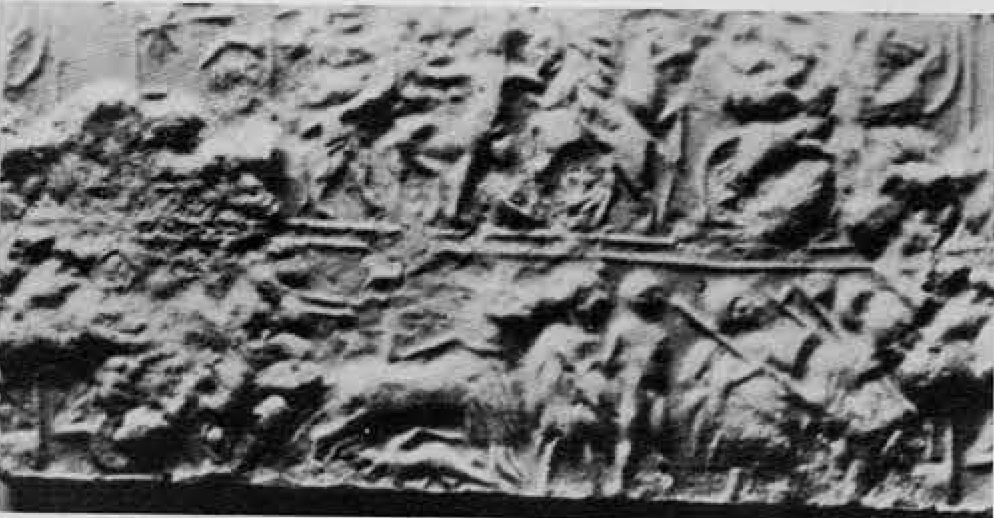
In excavating the plundered mudbrick mausolea of the rulers of the Third Dynasty of Ur (ca 2113-2006 B.C.), the last era of Sumerian political authority in Mesopotamia, Woolley believed that he had evidence for the continuance of human sacrifices at royal funerals. These tombs are designed like large private houses with burials in the vaults beneath them. Woolley believed that the earlier royal tombs had also had some kind of superstructure. When these later royal tombs were sacked at the time of the conquest of Ur by the Elamites from southwestern Iran at the very end of the third millennium B.C., the skeletons had been assembled and burned as an act of desecration. Among what remained there was evidence of men, women and children, leading Woolley to think that there had been victims here with the primary royal burials. But the evidence for such a conjecture is sparse and unconvincing, even though we know independently that in this dynasty some kings assumed divinity in their lifetime. Thereafter there is no evidence for such victims in Mesopotamia; though, by an interesting coincidence, there is more than a suspicion of them in Elam in the second millennium B.C.
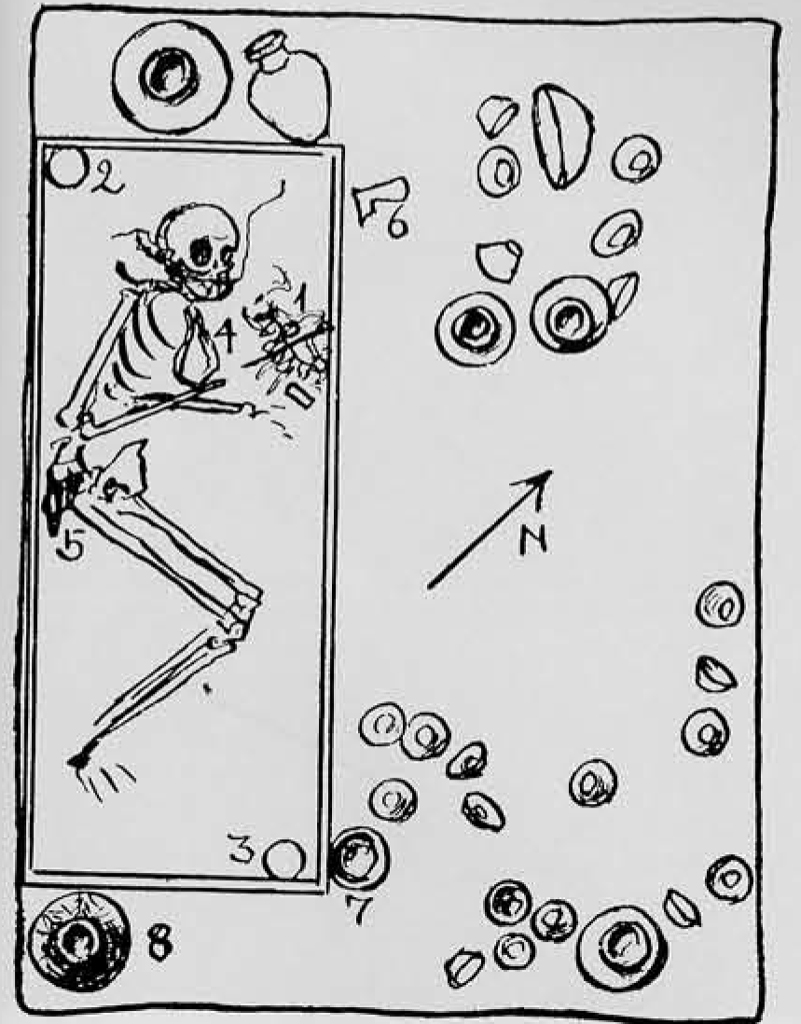
What then may we conclude, fifty years on, about the people buried in the Early Dynastic IIIA royal tombs at Ur? First, the relative certainties: the burials of a woman, named and titled nin (RT. 800) on a lapis lazuli banquet seal and of another woman with an uninscribed gold seal bearing a comparable banquet scene (RT. 1054); in association with RT. 580 a lapis lazuli banquet seal inscribed for a priestess of Pabilsag, who, judging at present only from much later texts, might already have been regarded as Nanna’s brother; three small graves of men with few human victims and no surviving seals (RTs. 1618, 1631 and 1648); victims who were members of the inner households; no clear evidence for the self-immolation of wives and children—included in the list given in the ‘Burial of Gilgamesh’ fragment—at the time of the primary burial. Then some possibilities: the grave of a man (PG. 755), distinguished by the unique splendour of its equipment, but without human sacrifices, whose name is that of a man titled ‘Iugal’ on a contest seal in the burial of a woman (RT 1054)—in short, at least one ‘lugal’ not in a royal tomb on Woolley’s criteria; a second man specifically called ‘lugal’ of Ur, with a wife not titled ‘nin’, leaving a seal in RT. 1050, which might be another female grave rather than his own.
The burial with human victims as well as the primary burial is clearly a special rite for special people—but what made them so? Not, it would appear, the mere fact of `royalty’ as we now understand it. We still know too little of family relationships within the Early Dynastic Sumerian ruling families, of the nature of their marriages, of their lines of inheritance, of the distribution of ranks, titles and religious offices, and their precise contemporary terminology, confidently to analyse the sociology of the royal tombs. For the men it may be a question of the extent to which in life they had assumed divine or semi-divine status, like some of the rulers of the later Third Dynasty of Ur. For the women the case is more complex still and may have turned not so much on whether or not they were ‘queens’ in a modern sense, as on whether or not they had been for some period of their lives ‘wife of Nanna’ or some comparable ranking in the temple hierarchy of Ur. On this kind of interpretation the apparent predominance of women would be directly associated with the cult of the city-god at Ur and may well not represent any general Sumerian tradition. It is unlikely that the ‘Burial of Gilgamesh’ fragment describes such burials, though the ‘Exaltation of Inanna’ may have a distant allusion to them. In any event it is much too soon to assume that the rulers of all Sumerian city-states at this time were buried in this particular way; the cult of Nanna may have had much more to do with them than is yet established. It may well be another fifty years before this aspect of Sumerian society is elucidated for us. It is a crucial problem, for it involves the rituals of life in Sumerian cities as much as the rites of death. It is likely to be answered by a combination of complementary studies: those so brilliantly developed by Woolley, “Giver of Life to the City of Ur,” and those for so long, and happily still, promoted with such skill, energy and perception by a distinguished resident of Philadelphia, Professor S. N. Kramer, who has done so much in the last fifty years to allow the Sumerians to speak again through their written legacy.

